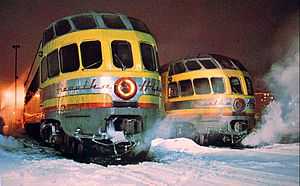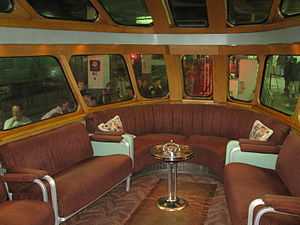Skytop Lounge
| Skytop Lounge | |
|---|---|
|
Two Skytop Lounges in their second Milwaukee Road paint scheme, matching Union Pacific colours. These cars were part of the Twin Cities Hiawatha equipment pool. | |
|
The interior of a Skytop Lounge, photographed in 2011 at National Train Day in Union Station, Chicago. | |
| In service | 1948–1977 |
| Manufacturer |
Pullman-Standard (sleepers) Milwaukee Road (parlor-lounges) |
| Replaced | Beaver Tail |
| Number built | 6 sleeping cars and 4 observation lounges |
| Capacity |
Sleeping car:
Lounge:
|
| Operator |
|
The Skytop Lounges were a fleet of streamlined passenger cars with the parlor-lounge cars built by the Chicago, Milwaukee, St. Paul and Pacific Railroad ("the Milwaukee Road") and sleeper-lounges built by Pullman-Standard in 1948. The cars were designed by famed industrial designer Brooks Stevens. The fleet included both parlor-lounges and sleeping cars. The lounges entered service in 1948 on the Twin Cities Hiawatha, while the sleeping cars were used on the long-distance Olympian Hiawatha. In 1964 the Milwaukee Road sold the sleeping cars to the Canadian National Railway, who operated them until 1977. The parlor cars continued in service with the Milwaukee Road until 1970, when they were retired.
Background
In 1935, the Milwaukee Road introduced the original Hiawatha between Chicago and the Twin Cities to great acclaim. The new trains covered the 420 miles (680 km) in 7 hours. Their equipment included the popular "Tip-Top-Tavern" and the distinctive "Beaver Tail" lounge observation cars. From the beginning the Hiawathas were known for speed and stylish design.[1]:28 Such was the success of the train that the Milwaukee Road would introduce new equipment again in 1936, 1937, 1938, and 1942.[2]
The Second World War prevented additional improvements, but by 1947 the Milwaukee Road was looking to improve its services. For the next and as it turned out final equipment set for the Twin Cities Hiawatha the Milwaukee Road turned to Brooks Stevens, an industrial designer and Milwaukee native. Beyond the Twin Cities Hiawathas, the Milwaukee Road planned to relaunch the transcontinental Olympian with new streamlined equipment, a new schedule, and a new name: the Olympian Hiawatha.[1]:90
Design
Breaking with the "Beaver Tail" design, the rear of the Skytop Lounge was 90% glass, with multiple rows of windows reaching up to form the ceiling. In the four parlor-lounges this "solarium" contained 12 seats, with an additional 24 seats in the interior of the car. At the front of the car was a four-seat drawing room. The interior featured wood paneling, characteristic of Milwaukee Road designs.[1]:93 The Milwaukee Road contracted with Pullman-Standard for six sleeping cars based on the parlor-lounge design. The sleeping cars featured reduced seating in the solarium to make room for eight double bedrooms. Pullman-Standard did not adopt wood paneling for its interiors.[1]:160; 170–171
Service history
The parlor-lounge Skytop Lounges entered service on the Morning and Afternoon Hiawathas on May 29, 1948. The Milwaukee Road touted the lounges as "the finishing touch to a perfect train."[1]:90 On April 1, 1969 the Milwaukee Road removed the lounges from the Morning Hiawatha. Skytop Lounges continued to operate on the Afternoon Hiawatha. The Milwaukee Road discontinued the Afternoon Hiawatha on January 23, 1970, ending the use of Skytop Lounges by the Milwaukee Road.[1]:126–127
The sleeping cars spent even less time in Milwaukee service. Pullman-Standard delivered the cars between December 1948 and January 1949 for use on the Olympian Hiawatha, which operated between Chicago and Tacoma, Washington. The Milwaukee Road discontinued the Olympian Hiawatha on May 22, 1961, in the face of mounting passenger losses.[1]:170; 187 In 1964 the Milwaukee Road sold all six to the Canadian National Railway (along with six of the Super Domes), which dubbed them "Skyview" lounges and put them into service on the Ocean.[3]:30 The Canadian National Railway took them out of service in the early 1970s and disposed of them in 1977.[3]:89 Two of the sleeping cars later became part of the SS Lansdowne, a floating restaurant in Detroit, Michigan. After that venture failed the remains of the cars were purchased by the Milwaukee Road Historical Association in 2009 and shipped to a museum in Montevideo, Minnesota.[4]
Cars built
Ten cars were built altogether:[1]:259–260
| Name | Number | Builder | Date | Type | Status |
|---|---|---|---|---|---|
| Cedar Rapids | 186 | Milwaukee Road | 1948 | Parlor-lounge | Retired in 1970. Now belongs to Friends of the 261. |
| Coon Rapids | 187 | Milwaukee Road | 1948 | Parlor-lounge | Retired in 1970. Stored by the Escanaba and Lake Superior Railroad.[5] |
| Dell Rapids | 188 | Milwaukee Road | 1948 | Parlor-lounge | Retired in 1970. On display at the Museum of Arts and Sciences in Daytona Beach, Florida.[5] |
| Priest Rapids | 189 | Milwaukee Road | 1948 | Parlor-lounge | Scrapped in 1970. |
| Alder Creek | 12 | Pullman-Standard | 1948 | Sleeper-lounge | Sold to CN in 1964 and renamed Mahone (#1900). Scrapped in 1977.[5] |
| Arrow Creek | 14 | Pullman-Standard | 1948 | Sleeper-lounge | Sold to CN in 1964 and renamed Malpeque (#1901). Now stored in Montevideo, Minnesota.[4] |
| Coffee Creek | 15 | Pullman-Standard | 1948 | Sleeper-lounge | Sold to CN in 1964 and renamed Fundy (#1902). Being restored in Alamosa, Colorado.[4] |
| Gold Creek | 16 | Pullman-Standard | 1948 | Sleeper-lounge | Sold to CN in 1964 and renamed Trinity (#1903). Now stored in Montevideo, Minnesota.[4] |
| Marble Creek | 17 | Pullman-Standard | 1949 | Sleeper-lounge | Sold to CN in 1964 and renamed Baddeck (#1904). Scrapped; date unknown.[5] |
| Spanish Creek | 18 | Pullman-Standard | 1949 | Sleeper-lounge | Sold to CN in 1964 and renamed Gaspe (#1905). Scrapped in 1977.[5] |
References
- ↑ 1.0 1.1 1.2 1.3 1.4 1.5 1.6 1.7 Scribbins, Jim (1970). The Hiawatha Story. Milwaukee, WI: Kalmbach Publishing Company. LCCN 70107874. OCLC 91468.
- ↑ "Remember when the Hiawatha was the sleekest thing on the rails?". Milwaukee Journal. September 10, 1986.
- ↑ 3.0 3.1 Greenlaw, Christopher C. N. (2007). VIA Rail. Saint Paul, MN: MBI. ISBN 9780760325292. OCLC 71286639.
- ↑ 4.0 4.1 4.2 4.3 "Skytop hulks bound for museum" (PDF). Northstar News (Northstar Railway Historical Society) 40 (7): 3–4. July 2009.
- ↑ 5.0 5.1 5.2 5.3 5.4 "Milwaukee Road "Skytops"". Retrieved September 28, 2013.
External links
| Wikimedia Commons has media related to Skytop Lounge cars. |
| ||||||||||||||||||

